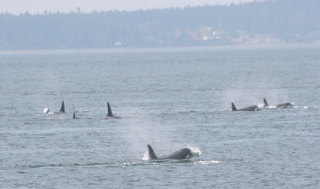There are whales sailing off Whidbey’s shores this month.
OK, technically, the orcinus orca is the largest species of the oceanic dolphin family. But most people still regard them as the “killer whales” of the seas.
And the orcas are here. After spending most of the summer in the San Juan Islands, orca pods are now beginning to venture south into inland waters for the fall and early winter months, traveling down Admiralty Inlet chasing chum salmon runs into lower Puget Sound.
Orca Network’s Susan Berta and Howard Garrett report tracking all three pods of the southern resident orcas off Whidbey Island, Port Townsend and as far south as the Kitsap Peninsula.
Why should anybody care?
“There’s an innate recognition of a kindred spirit that excites us,” Garrett said. “They are familiar yet magnificent creatures who remind us how vital the living, natural world can be. Whenever we see them, we get a sense of the wonder of nature.”
This time of year orcas can be spotted from the shoreline on Whidbey Island, the Kitsap and Olympic peninsulas, and the inland waters of Puget Sound. Orca Network encourages shore-based whale watching, or watching for whales while commuting on Washington State Ferries.
Historically, only J-pod remained in the inland waters during the fall and winter months, however the past nine or 10 years all three pods have been reported off Whidbey Island and in lower Puget Sound into December or later. Researchers can’t explain this shift, but one guess is the depletion of Chinook salmon in their normal feeding grounds during the fall and winter, coupled with increasing runs of chum salmon in inland waters.
According to the Center for Whale Research, the southern residents have had a tough year and seem not to be finding enough salmon.
The center usually has its annual survey completed by early summer, to confirm new births, deaths and the exact population of this endangered community of orcas. However, this summer the pods have not consistently stayed in the San Juan area, and when they are present, the pods are spread out over a large distance, making the survey more difficult. These behaviors indicate they are having a harder time finding salmon, especially Chinook, which is their favorite.
The Orca Network Web site — www.orcanetwork.org — keeps track of the orcas, but not without a lot of volunteer assistance.
“We are asking for your help in keeping track of the orcas and other whales, and request that you call in whale sightings so we can get the information as soon as possible,” Berta said.
“Whale reports may be called in to our toll-free number at 1-866-672-2638, or you can e-mail reports to us at info@orcanetwork.org.”
Berta said the data needed includes location, time, direction of travel, approximate number of whales, and if there are any adult males with large dorsal fins, plus any behaviors such as breaching, spy-hops or feeding.
Howard added that he’s seen people break out in smiles whenever they spot an orca, from shore or on a boat.
“There is a special joy that comes to folks coming in contact with these animals,” he said.



